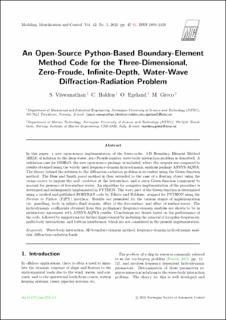| dc.contributor.author | Viswanathan, Savin | |
| dc.contributor.author | Holden, Christian | |
| dc.contributor.author | Egeland, Olav | |
| dc.contributor.author | Greco, Marilena | |
| dc.date.accessioned | 2021-11-25T08:03:47Z | |
| dc.date.available | 2021-11-25T08:03:47Z | |
| dc.date.created | 2021-11-21T20:43:55Z | |
| dc.date.issued | 2021 | |
| dc.identifier.citation | Modeling, Identification and Control. 2021, 42 (2), 47-81. | en_US |
| dc.identifier.issn | 0332-7353 | |
| dc.identifier.uri | https://hdl.handle.net/11250/2831374 | |
| dc.description.abstract | In this paper, a new open-source implementation of the lower-order, 3-D Boundary Element Method (BEM) of solution to the deep-water, zero Froude-number wave-body interaction problem is described. A validation case for OMHyD, the new open-source package, is included, where the outputs are compared to results obtained using the widely used frequency-domain hydrodynamic analysis package ANSYS-AQWA. The theory behind the solution to the diffraction-radiation problem is re-visited using the Green function method. The Hess and Smith panel method is then extended to the case of a floating object using the image-source to impose the wall condition at the free-surface, and a wavy Green function component to account for presence of free-surface waves. An algorithm for computer implementation of the procedure is developed and subsequently implemented in PYTHON. The wavy part of the Green function is determined using a verified and published FORTRAN code by Teleste and Noblesse, wrapped for PYTHON using the Fortran to Python (F2PY) interface. Results are presented for the various stages of implementation viz. panelling, body in infinite fluid domain, effect of the free-surface, and effect of surface-waves. The hydrodynamic coefficients obtained from this preliminary frequency-domain analysis are shown to be in satisfactory agreement with ANSYS-AQWA results. Conclusions are drawn based on the performance of the code, followed by suggestions for further improvement by including the removal of irregular-frequencies, multi-body interactions, and bottom interference, which are not considered in the present implementation. | en_US |
| dc.language.iso | eng | en_US |
| dc.rights | Navngivelse 4.0 Internasjonal | * |
| dc.rights.uri | http://creativecommons.org/licenses/by/4.0/deed.no | * |
| dc.title | An Open-Source Python-Based Boundary-Element Method Code for the Three-Dimensional, Zero-Froude, Infinite-Depth, Water-Wave Diffraction-Radiation Problem | en_US |
| dc.type | Journal article | en_US |
| dc.type | Peer reviewed | en_US |
| dc.description.version | publishedVersion | en_US |
| dc.source.pagenumber | 47-81 | en_US |
| dc.source.volume | 42 | en_US |
| dc.source.journal | Modeling, Identification and Control | en_US |
| dc.source.issue | 2 | en_US |
| dc.identifier.doi | 10.4173/mic.2021.2.2 | |
| dc.identifier.cristin | 1956991 | |
| dc.relation.project | Norges forskningsråd: 237896 | en_US |
| cristin.ispublished | true | |
| cristin.fulltext | original | |
| cristin.qualitycode | 1 | |

